Cornering basics part 4 - Picking the right line
Discussion
Many years ago, I posted a series of articles on cornering and when I re-edited them for the book, I realised I hadn't really finished them off properly. You can read the first three instalments here:
Part 1, part 2 and part 3.
Some 8 years later, here's part 4, in which I'll look at cornering lines on the road. If you've bought the book, don't worry - this will be included as part of the upcoming update.
Lines...
So you’ve seen the corner in the distance, you’ve used your observation skills to assess the severity of the corner, you’ve positioned your car correctly on the approach, reduced your speed appropriately with the brakes, changed down to the correct gear…
What next?
It’s just a case of turning the wheel and steering round the corner isn’t it?
Well, in the simplest of terms, yes, it is, but this is a post about advanced driving and you’d be disappointed if I left it at that wouldn’t you?
In fact, there’s quite a lot more to think about – when to turn the wheel, how to plan your line through the corner, how to maintain vehicle balance with the throttle, when to press the accelerator, how to make best use of the roads camber, where to look, how to use your exit from one corner to best advantage when planning the next corner…
Like I said – there’s a lot more to think about, so let’s start with how to pick the best cornering line.
I’ll use a nice, straightforward 90 degree corner as my example, but these principles can be used for any corner of any degree of tightness. So, let’s look at our corner…
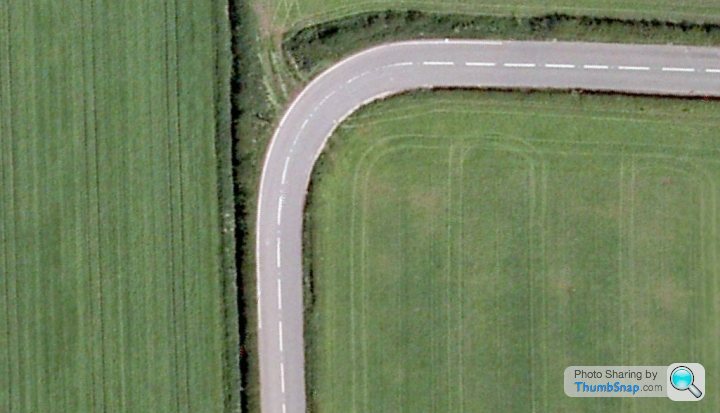
Like I said – a nice, straightforward 90 degree right-hand bend. Now, if this corner were on a racetrack, our choice of line would be simple – if you can use the full width of the road and you’ve no fear of anything coming the other way, the ideal line would start from the extreme left-hand side of the road, cut right over to the offside at the corner’s apex, and then go back out to the extreme left-hand side of the road on the exit of the corner. This would allow us to use the minimum amount of steering by turning the car through the shallowest arc. Just like the red line in the picture below:
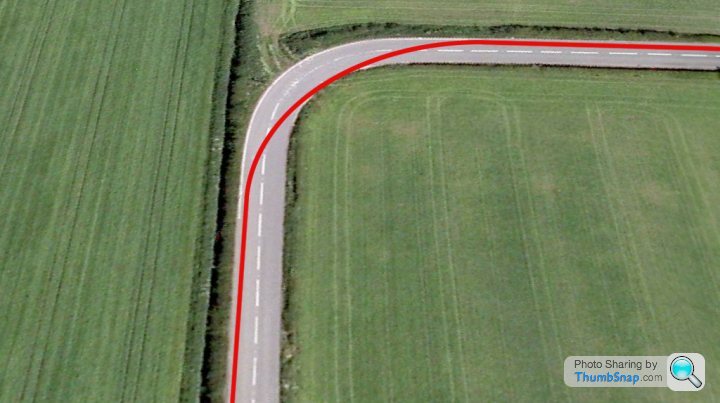
As you can see, the red line is a much wider arc than the corner itself, and would allow us to carry more speed whilst maintaining maximum balance. It would also give us the benefit of the crown camber if that’s how the road is constructed.
If you’ve got a full, unobstructed view of the road on the approach to this corner and there are no other hazards, then the above line is perfectly acceptable. The white centre-lines are only hazard lines, so there is no legal requirement to stick to the nearside. There are no “right” and “wrong” sides of the road in the UK, so where circumstances allow, “offsiding” on right-hand bends is a good, advanced technique.
Having said all that, it’s not often that offsiding will be appropriate – it’s rare that you’ll encounter the combination of a fully-sighted corner and no traffic which would allow you to take this line.
In most cases, our plan should be to keep mostly to the left of the white centre-line , and so the more obvious line would be as per the picture below:
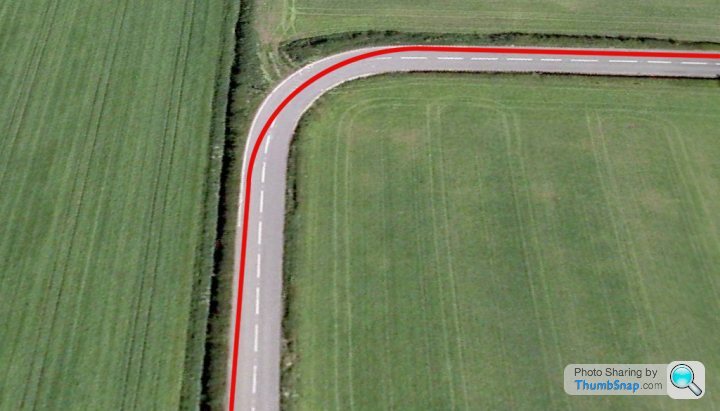
In this case, our position on entry and exit is well over to the nearside, but within the more restricted available space, we’ve still taken a line which prescribes the widest possible arc.
So – that’s that then. Simple.
Slow and late in – Quick and straight out
Come on – you should know me better than that by now! That line might be an ideal competition or racing line, but things are different on the road – we have many other pressing priorities than simply carrying maximum speed and balance through the corner. On the road, each corner is effectively new to us, we’re constantly evaluating the angle, camber, road surface condition, view, oncoming traffic, preceding traffic and nearside & offside hazards whilst looking as far ahead as possible to start the same assessment on the next bend, and even, occasionally, the one after that.
So with all those additional considerations, our line in most corners needs to change slightly to allow us to also maximise our view around the corner. The principle is quite simple – you use your own positioning to slightly “re-prescribe” the arc of the corner so that, in most cases, every corner “opens”.
Let me explain a bit further – some corners are designed with a constant arc, like the one in the picture above, whereas some corners “tighten” as you drive around them (the curve becomes tighter) and some corners “open” as you drive around them (the curve becomes less tight).
The corners which “open” are always easier to negotiate. If, for instance, you’re using the limit point method to assess the tightness, you’ll slow down to an appropriate speed for the entry of the corner, which is the tightest part and then as you turn in to the corner, it will start to become less and less tight and you can increase your acceleration through the corner, which keeps the car balanced and allows you to make nice, smooth progress.
The corners which “tighten” are less easy. On the approach, you’ll be assessing your speed against the more open part of the corner, and if you’re pressing on a bit, this will mean that, as the corner develops, your entry speed will turn out to be too high for the tighter part of the bend, so you’ll need to lose more speed, which – in turn – unsettles the car, weights up the steering and forces you to wait much longer before you can apply some throttle and start to straighten the steering wheel. This is not a recipe for smooth, advanced driving.
The principle we’ll apply to cornering lines on the road will mean that we’ll try to turn every corner into an “opening” corner by using a slightly different line from the traditional “racing” line. It will feel a little odd at first, and it’s not an easy technique to adapt to – particularly if you’re an experienced driver – but the benefits will, with time, start to become clear.
The technique for a right-hand corner is to stay tight into the nearside for a bit longer than you normally would, before turning in to the corner with an initial turn which is slightly tighter than normal and aiming for an apex which is slightly later than you might normally aim for.
This “late turn in” will help to give you a better view of the corner as it develops and will allow you to see, at an earlier point, when the corner is starting to open up, so that you can start winding off the steering and start applying a firmer throttle. In very simple terms, it’s just a development of the old adage “slow in, quick out”. I call it “slow and late in, quick and straight out”.
For those visual learners amongst you, here’s a picture of the line in yellow, with the traditional “racing” line in red for comparison:
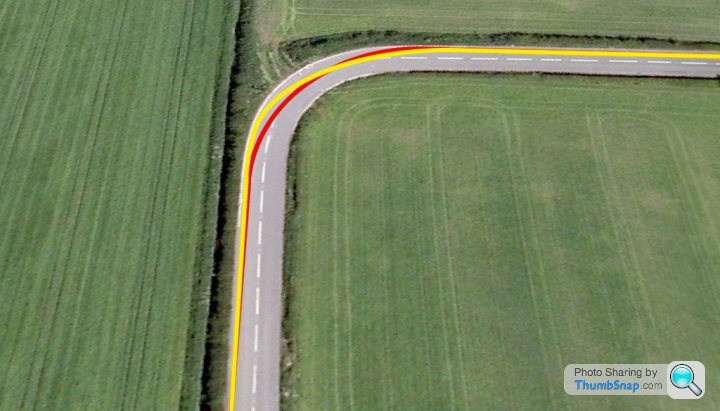
As you can see, the initial turn is sharper, and will require a slightly lower speed on entry, but that sharper turn very quickly starts to open up, and you’ll be straightening the car before you reach the apex and accelerating earlier out of the corner.
Going in slower really does allow you to exit faster!
So to summarise, for a right-hander, stay nearside for a little longer before making the initial turn. When you do turn in, turn a little sharper at first, aim for a later apex, and then accelerate out of the bend.
But what about a left-hander?
Well, the principle is exactly the same. In the UK and any other country which drives on the left, a left-hand bend will always be tighter then when travelling in the opposite direction.
But there is an advantage to left-hand bends. You’ve got much more room to adjust your position on the approach to a left-hander than you have on the approach to a right-hander. Let me explain a little further.
Approaching a right-hand bend, the best position is towards the nearside (left) side of the road. In reality, you’re never that far from the nearside anyway, so a move to the nearside is usually only quite a small one – maybe a foot at most.
But when approaching a left-hand bend, the best position is towards the offside (right) of the road. So we’ve actually got much more space to play with on the approach – the full width of the road in fact. If it’s safe, there is nothing wrong with taking a fully offside position on the approach to a left-hander. It will greatly improve your view on approach and help you to assess the tightness of the bend.
It’s not usually safe or appropriate to stay offside right up to a corner though, so the advice is to take a position as far offside as is safe when you’re a good distance away from a corner, but to move your position gradually back over the centre line as you get closer to the corner. If you use this gradual, diagonal approach to left-handers, you’ll not be caught out by any oncoming traffic, and more importantly, you won’t frighten the oncoming traffic!
Something like this:
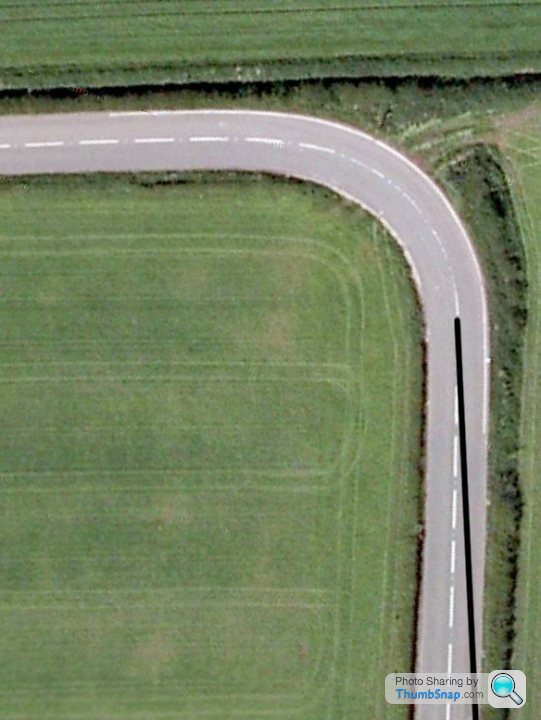
Your position on approach very much depends, of course, on traffic conditions, so if it’s perfectly clear, the above position will be fine, but should be adjusted to take into account any oncoming traffic so you may be straddling the centre-line or sitting just to the left of the centre line on approach.
As you get up to the corner, use the principle of slow and late in – quick and straight out, to take a line something like this:
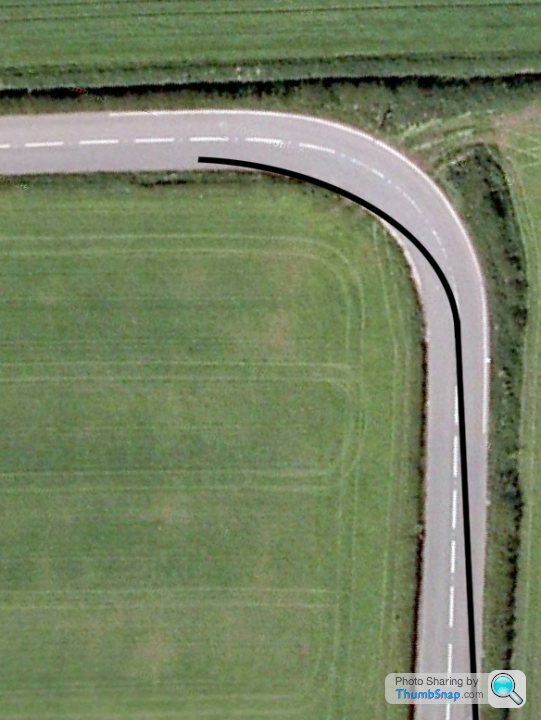
Now, you’ll notice I’ve left out the final exit line – this is because the exit of left-handers – just as with the entry – allows you more choice, depending on traffic and other hazards.
If your space is limited on the exit, you can stay to the left of the centre line:
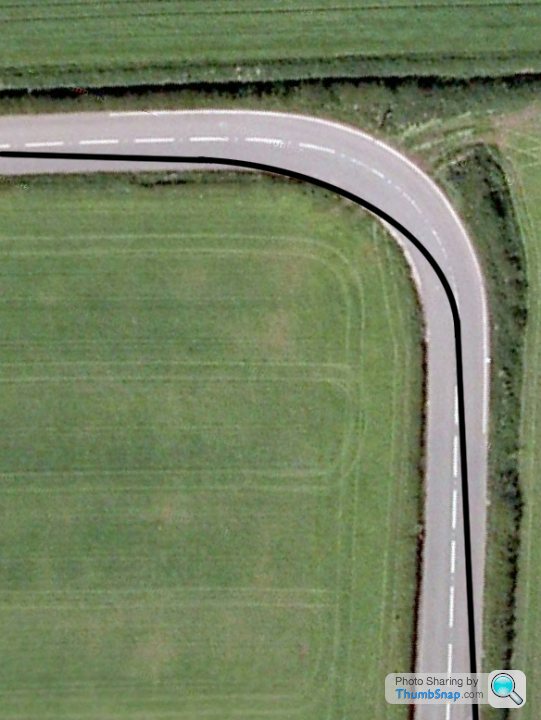
Or if your view opens up to a nice, empty road, then take full advantage of it:
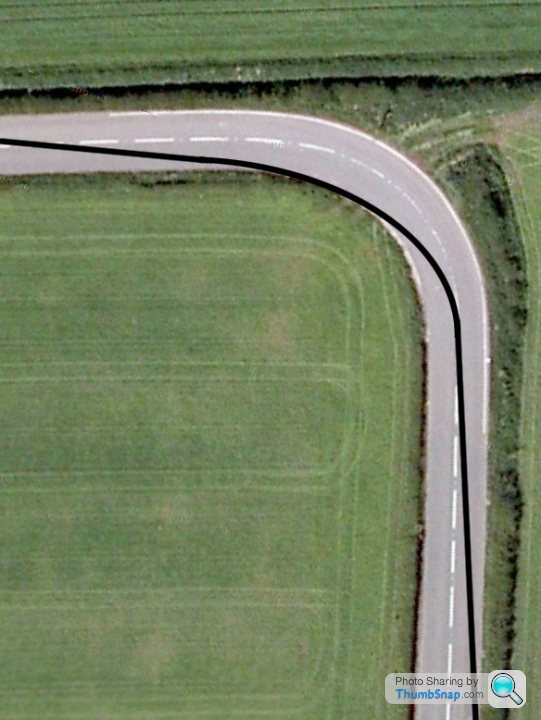
Now, it’s fairly unusual just to have one single bend like this – our British roads are far more complex than that, so you should keep your observations as far ahead as possible to try to identify the next corner, and the one after that. The important thing to consider is that your exit from one corner should be adjusted to give you the most appropriate entry to the next corner.
Just remember the key principle:
Slow and late in – Quick and straight out.
Part 1, part 2 and part 3.
Some 8 years later, here's part 4, in which I'll look at cornering lines on the road. If you've bought the book, don't worry - this will be included as part of the upcoming update.
Lines...
So you’ve seen the corner in the distance, you’ve used your observation skills to assess the severity of the corner, you’ve positioned your car correctly on the approach, reduced your speed appropriately with the brakes, changed down to the correct gear…
What next?
It’s just a case of turning the wheel and steering round the corner isn’t it?
Well, in the simplest of terms, yes, it is, but this is a post about advanced driving and you’d be disappointed if I left it at that wouldn’t you?
In fact, there’s quite a lot more to think about – when to turn the wheel, how to plan your line through the corner, how to maintain vehicle balance with the throttle, when to press the accelerator, how to make best use of the roads camber, where to look, how to use your exit from one corner to best advantage when planning the next corner…
Like I said – there’s a lot more to think about, so let’s start with how to pick the best cornering line.
I’ll use a nice, straightforward 90 degree corner as my example, but these principles can be used for any corner of any degree of tightness. So, let’s look at our corner…

Like I said – a nice, straightforward 90 degree right-hand bend. Now, if this corner were on a racetrack, our choice of line would be simple – if you can use the full width of the road and you’ve no fear of anything coming the other way, the ideal line would start from the extreme left-hand side of the road, cut right over to the offside at the corner’s apex, and then go back out to the extreme left-hand side of the road on the exit of the corner. This would allow us to use the minimum amount of steering by turning the car through the shallowest arc. Just like the red line in the picture below:

As you can see, the red line is a much wider arc than the corner itself, and would allow us to carry more speed whilst maintaining maximum balance. It would also give us the benefit of the crown camber if that’s how the road is constructed.
If you’ve got a full, unobstructed view of the road on the approach to this corner and there are no other hazards, then the above line is perfectly acceptable. The white centre-lines are only hazard lines, so there is no legal requirement to stick to the nearside. There are no “right” and “wrong” sides of the road in the UK, so where circumstances allow, “offsiding” on right-hand bends is a good, advanced technique.
Having said all that, it’s not often that offsiding will be appropriate – it’s rare that you’ll encounter the combination of a fully-sighted corner and no traffic which would allow you to take this line.
In most cases, our plan should be to keep mostly to the left of the white centre-line , and so the more obvious line would be as per the picture below:

In this case, our position on entry and exit is well over to the nearside, but within the more restricted available space, we’ve still taken a line which prescribes the widest possible arc.
So – that’s that then. Simple.
Slow and late in – Quick and straight out
Come on – you should know me better than that by now! That line might be an ideal competition or racing line, but things are different on the road – we have many other pressing priorities than simply carrying maximum speed and balance through the corner. On the road, each corner is effectively new to us, we’re constantly evaluating the angle, camber, road surface condition, view, oncoming traffic, preceding traffic and nearside & offside hazards whilst looking as far ahead as possible to start the same assessment on the next bend, and even, occasionally, the one after that.
So with all those additional considerations, our line in most corners needs to change slightly to allow us to also maximise our view around the corner. The principle is quite simple – you use your own positioning to slightly “re-prescribe” the arc of the corner so that, in most cases, every corner “opens”.
Let me explain a bit further – some corners are designed with a constant arc, like the one in the picture above, whereas some corners “tighten” as you drive around them (the curve becomes tighter) and some corners “open” as you drive around them (the curve becomes less tight).
The corners which “open” are always easier to negotiate. If, for instance, you’re using the limit point method to assess the tightness, you’ll slow down to an appropriate speed for the entry of the corner, which is the tightest part and then as you turn in to the corner, it will start to become less and less tight and you can increase your acceleration through the corner, which keeps the car balanced and allows you to make nice, smooth progress.
The corners which “tighten” are less easy. On the approach, you’ll be assessing your speed against the more open part of the corner, and if you’re pressing on a bit, this will mean that, as the corner develops, your entry speed will turn out to be too high for the tighter part of the bend, so you’ll need to lose more speed, which – in turn – unsettles the car, weights up the steering and forces you to wait much longer before you can apply some throttle and start to straighten the steering wheel. This is not a recipe for smooth, advanced driving.
The principle we’ll apply to cornering lines on the road will mean that we’ll try to turn every corner into an “opening” corner by using a slightly different line from the traditional “racing” line. It will feel a little odd at first, and it’s not an easy technique to adapt to – particularly if you’re an experienced driver – but the benefits will, with time, start to become clear.
The technique for a right-hand corner is to stay tight into the nearside for a bit longer than you normally would, before turning in to the corner with an initial turn which is slightly tighter than normal and aiming for an apex which is slightly later than you might normally aim for.
This “late turn in” will help to give you a better view of the corner as it develops and will allow you to see, at an earlier point, when the corner is starting to open up, so that you can start winding off the steering and start applying a firmer throttle. In very simple terms, it’s just a development of the old adage “slow in, quick out”. I call it “slow and late in, quick and straight out”.
For those visual learners amongst you, here’s a picture of the line in yellow, with the traditional “racing” line in red for comparison:

As you can see, the initial turn is sharper, and will require a slightly lower speed on entry, but that sharper turn very quickly starts to open up, and you’ll be straightening the car before you reach the apex and accelerating earlier out of the corner.
Going in slower really does allow you to exit faster!
So to summarise, for a right-hander, stay nearside for a little longer before making the initial turn. When you do turn in, turn a little sharper at first, aim for a later apex, and then accelerate out of the bend.
But what about a left-hander?
Well, the principle is exactly the same. In the UK and any other country which drives on the left, a left-hand bend will always be tighter then when travelling in the opposite direction.
But there is an advantage to left-hand bends. You’ve got much more room to adjust your position on the approach to a left-hander than you have on the approach to a right-hander. Let me explain a little further.
Approaching a right-hand bend, the best position is towards the nearside (left) side of the road. In reality, you’re never that far from the nearside anyway, so a move to the nearside is usually only quite a small one – maybe a foot at most.
But when approaching a left-hand bend, the best position is towards the offside (right) of the road. So we’ve actually got much more space to play with on the approach – the full width of the road in fact. If it’s safe, there is nothing wrong with taking a fully offside position on the approach to a left-hander. It will greatly improve your view on approach and help you to assess the tightness of the bend.
It’s not usually safe or appropriate to stay offside right up to a corner though, so the advice is to take a position as far offside as is safe when you’re a good distance away from a corner, but to move your position gradually back over the centre line as you get closer to the corner. If you use this gradual, diagonal approach to left-handers, you’ll not be caught out by any oncoming traffic, and more importantly, you won’t frighten the oncoming traffic!
Something like this:

Your position on approach very much depends, of course, on traffic conditions, so if it’s perfectly clear, the above position will be fine, but should be adjusted to take into account any oncoming traffic so you may be straddling the centre-line or sitting just to the left of the centre line on approach.
As you get up to the corner, use the principle of slow and late in – quick and straight out, to take a line something like this:

Now, you’ll notice I’ve left out the final exit line – this is because the exit of left-handers – just as with the entry – allows you more choice, depending on traffic and other hazards.
If your space is limited on the exit, you can stay to the left of the centre line:

Or if your view opens up to a nice, empty road, then take full advantage of it:

Now, it’s fairly unusual just to have one single bend like this – our British roads are far more complex than that, so you should keep your observations as far ahead as possible to try to identify the next corner, and the one after that. The important thing to consider is that your exit from one corner should be adjusted to give you the most appropriate entry to the next corner.
Just remember the key principle:
Slow and late in – Quick and straight out.
Just wondering Reg how your "slow and late in" dove-tails together with "hinting" on the approach to a corner. I believed that hinting took up the slack in the steering and transmitted to the tyre blocks the need to firm up in the direction of the corner, but done early in the approach.
It's difficult to describe but "hinting" has been described as a subtle pulling of the skin on your hand against the steering wheel, no percieved turn of the steering wheel. Your vehicle begins to move in the direction hinted then you apply an appropriate amount of traditional steering as dictated by the severity of the bend.
I think that I have made a difference to the smoothness of my cornering by its application.
It's difficult to describe but "hinting" has been described as a subtle pulling of the skin on your hand against the steering wheel, no percieved turn of the steering wheel. Your vehicle begins to move in the direction hinted then you apply an appropriate amount of traditional steering as dictated by the severity of the bend.
I think that I have made a difference to the smoothness of my cornering by its application.
titian said:
Just wondering Reg how your "slow and late in" dove-tails together with "hinting" on the approach to a corner. I believed that hinting took up the slack in the steering and transmitted to the tyre blocks the need to firm up in the direction of the corner, but done early in the approach.
It's difficult to describe but "hinting" has been described as a subtle pulling of the skin on your hand against the steering wheel, no percieved turn of the steering wheel. Your vehicle begins to move in the direction hinted then you apply an appropriate amount of traditional steering as dictated by the severity of the bend.
I think that I have made a difference to the smoothness of my cornering by its application.
You're getting ahead of me! There will be a part 5 which deals with physically driving the car around the corner, steering and throttle inputs etc.It's difficult to describe but "hinting" has been described as a subtle pulling of the skin on your hand against the steering wheel, no percieved turn of the steering wheel. Your vehicle begins to move in the direction hinted then you apply an appropriate amount of traditional steering as dictated by the severity of the bend.
I think that I have made a difference to the smoothness of my cornering by its application.
I just haven't written it yet!
To give you a brief answer for the time being - the lines I've described do not preclude the use of a smooth, progressive initial steering input. In other words, these lines can be used with the steering technique you've described, it's just that the turn in is perfomed slightly more quickly than the "turn out" (removing the applied steering lock).
titian said:
Just wondering Reg how your "slow and late in" dove-tails together with "hinting" on the approach to a corner. I believed that hinting took up the slack in the steering and transmitted to the tyre blocks the need to firm up in the direction of the corner, but done early in the approach.
It's difficult to describe but "hinting" has been described as a subtle pulling of the skin on your hand against the steering wheel, no percieved turn of the steering wheel. Your vehicle begins to move in the direction hinted then you apply an appropriate amount of traditional steering as dictated by the severity of the bend.
I think that I have made a difference to the smoothness of my cornering by its application.
You're subtly shifting the weight of the car prior to turn in- the holy grail of smooth fast cornering.It's difficult to describe but "hinting" has been described as a subtle pulling of the skin on your hand against the steering wheel, no percieved turn of the steering wheel. Your vehicle begins to move in the direction hinted then you apply an appropriate amount of traditional steering as dictated by the severity of the bend.
I think that I have made a difference to the smoothness of my cornering by its application.
I tend to use the "smooth, late turn-in (pushing, rather than pulling, the wheel to hint/take up the slack) , keeping the vehicle balanced and looking for the exit" in cornering.
I haven't always done so and suspect that I am now in a tiny minority.
I see all kinds of weird cornering when out and about, from people in both common vehicles and in high performance exotica:
...Stabbing the brakes and/or changing gear mid-bend, turning far too early and running wide, weaving around mid-bend, driving down the middle of the road (or on the wrong side) around narrow blind bends, turning the steering wheel too much etc.
I haven't always done so and suspect that I am now in a tiny minority.
I see all kinds of weird cornering when out and about, from people in both common vehicles and in high performance exotica:
...Stabbing the brakes and/or changing gear mid-bend, turning far too early and running wide, weaving around mid-bend, driving down the middle of the road (or on the wrong side) around narrow blind bends, turning the steering wheel too much etc.
MC Bodge said:
turning the steering wheel too much etc.
I like to use a minimalist approach too, applying as little steering as possible/necessary and one smooth movement into and out of lock. Slow and late in is probably very natural to a biker, it gives you the maximum options on how to deal with the corner as the sight lines open up.
Gassing Station | Advanced Driving | Top of Page | What's New | My Stuff



